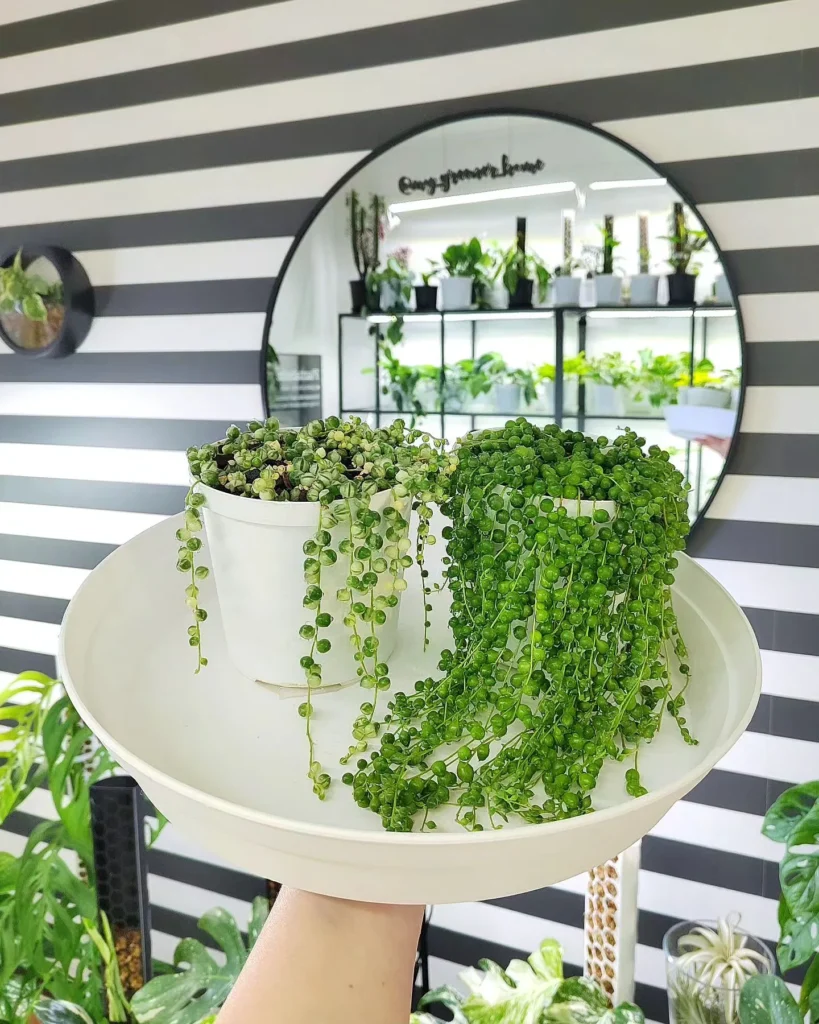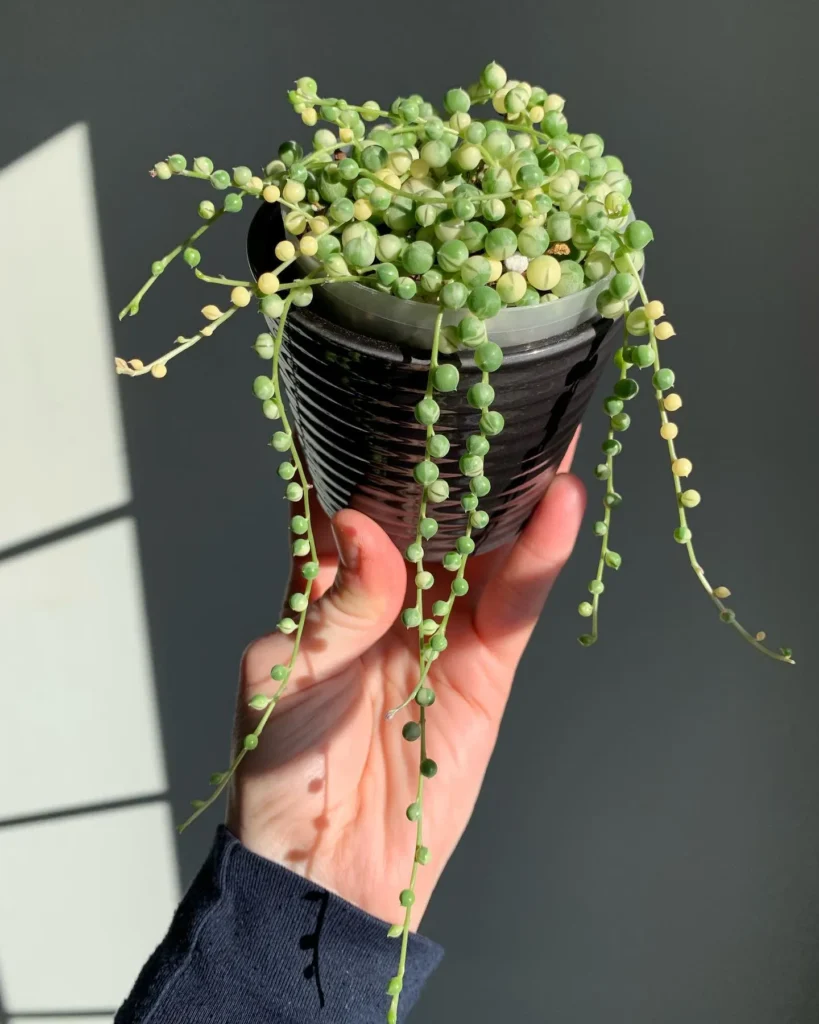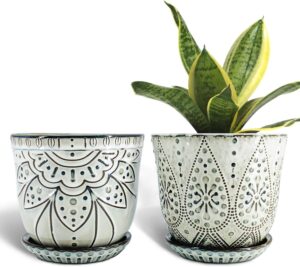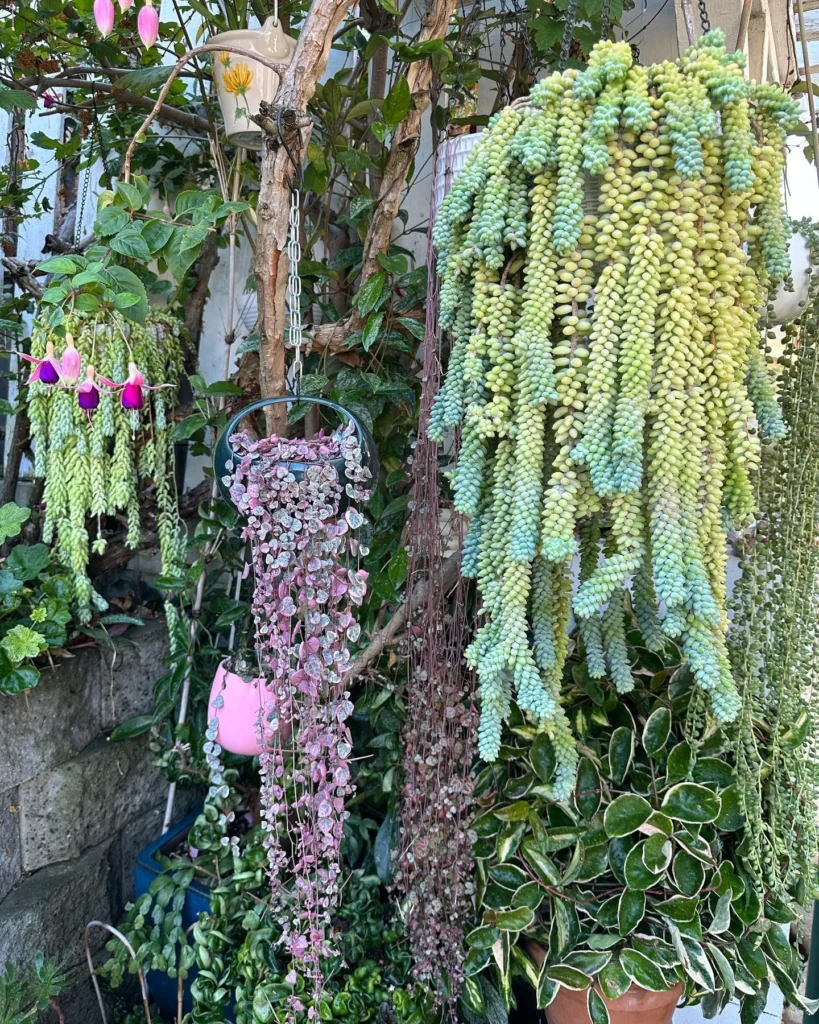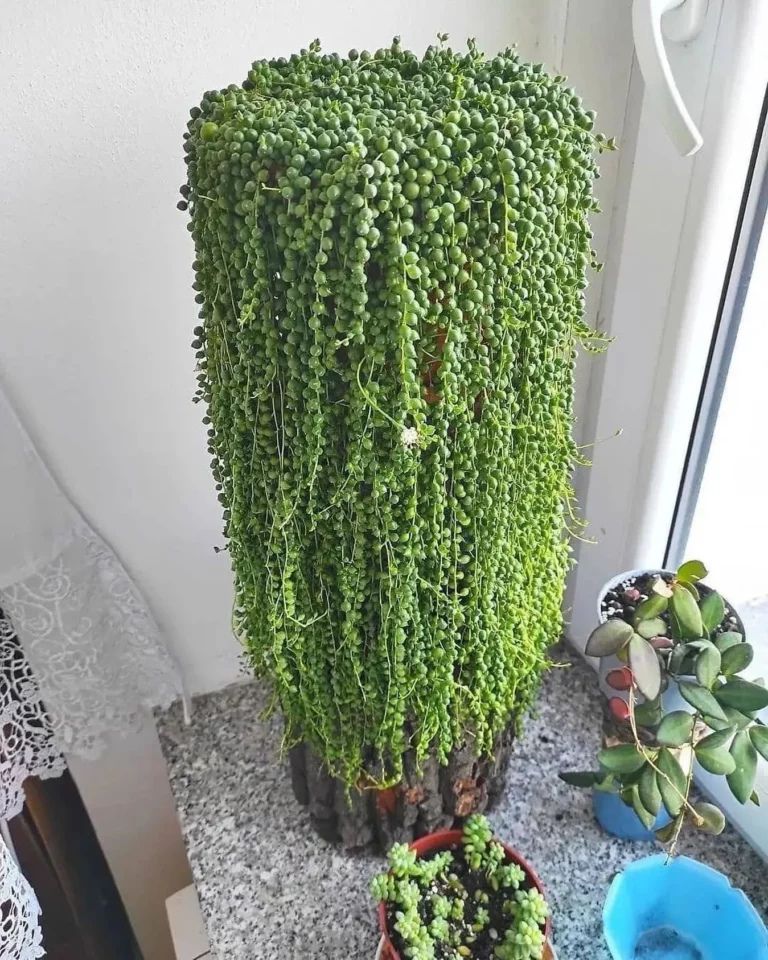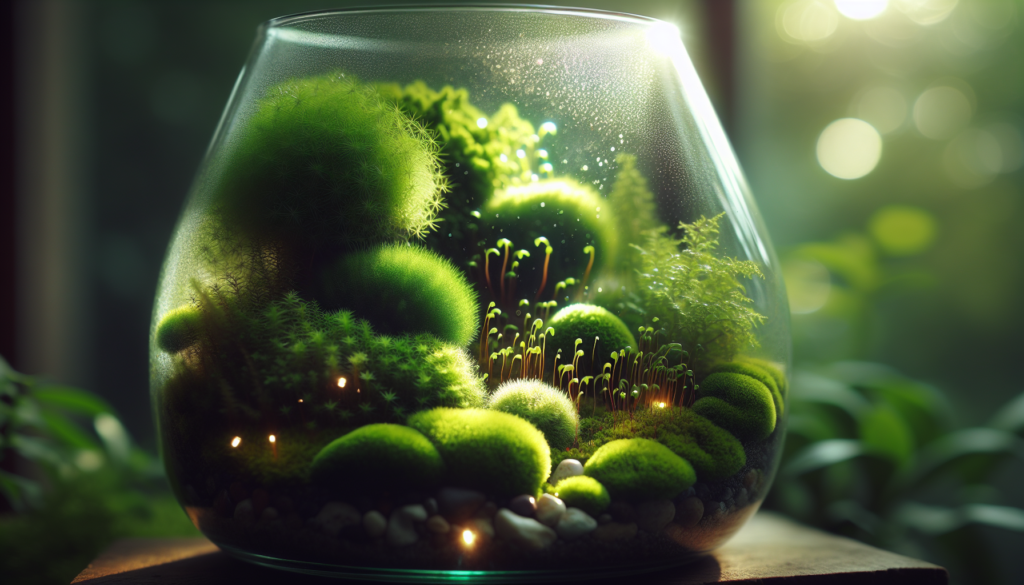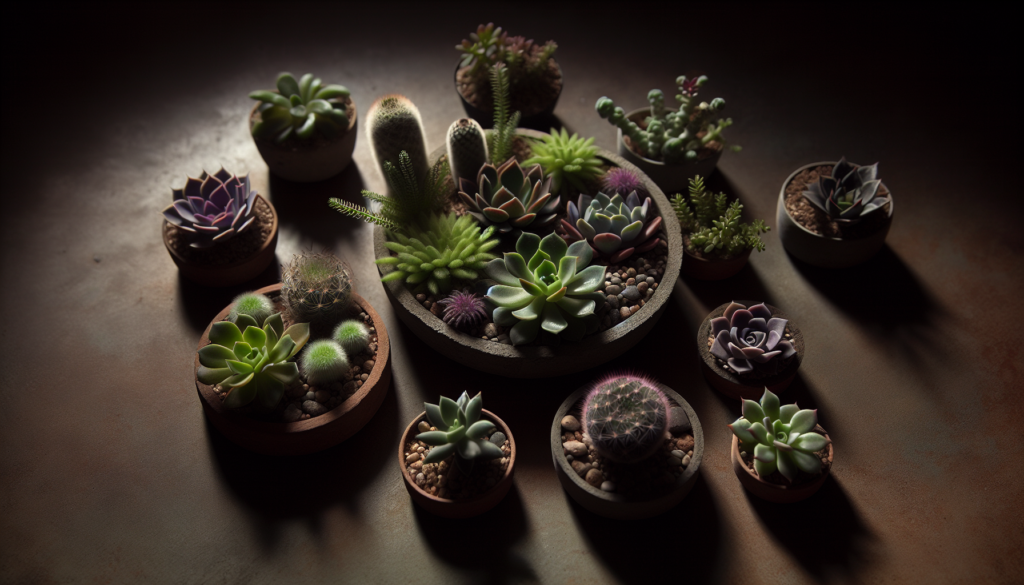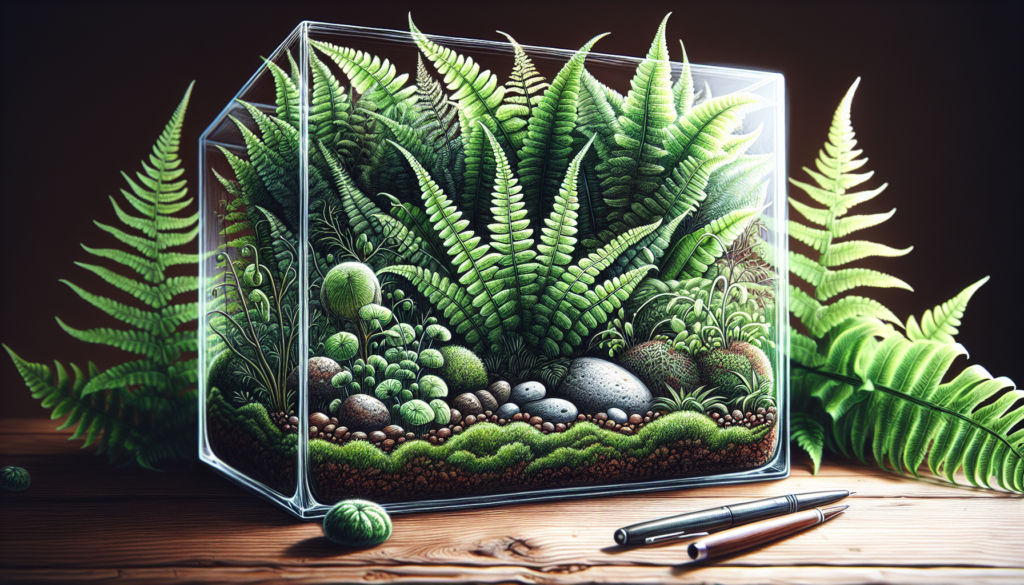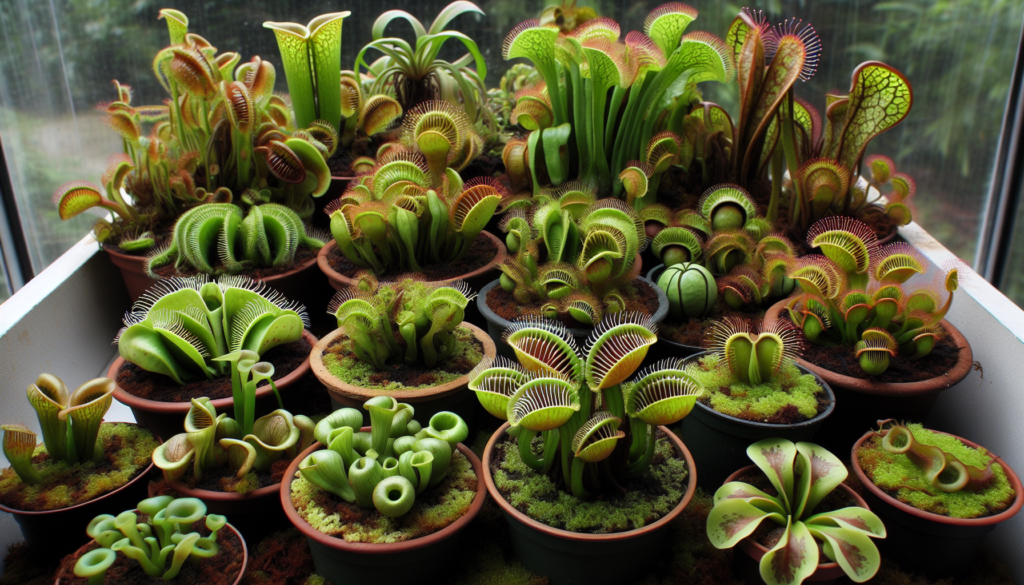The String of Pearls plant is a captivating succulent that stands out with its unique appearance. Its long, trailing stems are adorned with unusual pea-shaped leaves, giving it a distinct look. The leaves are round in shape and have a fascinating feature – a transparent “window” that allows sunlight to penetrate through. This adaptation enables the plant to absorb optimal sunlight for photosynthesis.
With its trailing growth habit, the String of Pearls can grow stems that reach up to three feet in length, making it an excellent choice for hanging baskets or macrame hangers. Its delicate yet robust round leaves add a touch of elegance and charm to any indoor or outdoor space.
- Long strings of pea-shaped round leaves
- Leaves have a transparent “window” for sunlight
- Trailing growth habit with stems up to three feet long
- Apple green leaves, with variegated forms available
Light Requirements for String of Pearls
String of Pearls, a unique and popular succulent, requires specific light requirements to ensure its healthy growth and vibrant appearance. Providing the right amount of light is crucial for the well-being of your plant.
When growing String of Pearls indoors, it is best to place the plant near a sunny window, where it can receive at least four hours of direct sunlight daily. This bright, indirect light will provide the necessary energy for photosynthesis and promote optimal growth.
However, it is important to be cautious of too much direct sunlight, as it can lead to sunburn on the delicate leaves of the String of Pearls. If you notice browning or discoloration of the leaves, it may be a sign that the plant is receiving too much sunlight. In such cases, consider moving the plant to a spot with slightly less sunlight or provide some shade during the hottest parts of the day.
When growing String of Pearls outdoors, the plant can tolerate partial sun or bright shade. This makes it a versatile choice for various garden conditions. However, it is important to note that during hot afternoons, providing some shade can help prevent the plant from drying out or experiencing heat stress.
Watering String of Pearls
Proper watering is crucial for the health of your String of Pearls. While it is a succulent and can tolerate drought, it still requires regular watering. Follow these watering guidelines to ensure the optimal growth and well-being of your String of Pearls:
- During the growing season, water the plant when the top two inches of soil feel dry. This will help prevent overwatering and root rot.
- When watering, make sure to thoroughly soak the soil until the water runs out of the drainage holes of the pot. This ensures that the roots receive adequate moisture.
- Allow the soil to dry completely before watering again. Overwatering can be harmful to the plant and may lead to root rot.
- In the fall and winter, water sparingly. Only water the plant when the pea-like leaves start to shrivel and the soil feels dry. This is an indication that the plant is entering its dormant period.
Fertilizing String of Pearls
Instagram @grow.mama.grow
Proper fertilizing is essential for the healthy growth of your String of Pearls. Regular feedings during the growing season will provide the necessary nutrients for vibrant foliage and lush trailing stems.
How to Fertilize
Use a diluted houseplant fertilizer at half strength to avoid overfeeding. Apply the fertilizer once a month during the growing season, which typically starts in spring and extends to early fall.
Fertilizing Schedule
During the plant’s dormant period in fall and winter, cut back on fertilizing. To promote healthy growth while conserving energy, feed your String of Pearls once every three months during this period.
Applying the Fertilizer
Pour the diluted fertilizer solution directly into the potting soil, ensuring that it reaches the root zone. Avoid applying the fertilizer directly onto the leaves, as this can cause burns. Water the plant lightly after fertilizing to distribute the nutrients evenly.
Choosing the Right Fertilizer
Opt for a well-balanced, water-soluble houseplant fertilizer with an NPK ratio of approximately 20-20-20. This balanced ratio ensures that your String of Pearls receives the necessary nitrogen, phosphorus, and potassium for healthy growth.
Benefits of Monthly Feedings
Monthly feedings replenish the nutrients in the soil that can deplete over time. They provide the String of Pearls with the essential nourishment it needs to thrive, resulting in vibrant and robust growth.
- Use a diluted houseplant fertilizer at half strength
- Apply the fertilizer once a month during the growing season
- Cut back on fertilizing to once every three months during the dormant period
- Pour the diluted fertilizer solution directly into the potting soil
- Avoid applying fertilizer directly onto the leaves
- Choose a well-balanced, water-soluble houseplant fertilizer
- Benefits include replenishing nutrients and promoting healthy growth
Potting String of Pearls
String of Pearls, a popular succulent known for its unique trailing growth habit, requires proper potting to prevent root rot and promote healthy growth. Follow these potting tips to ensure your String of Pearls thrives:
Choose a Well-Draining Potting Mix
String of Pearls needs a well-draining potting mix to prevent waterlogged soil and root rot. Opt for a sandy, cactus, or succulent mix that promotes drainage. Alternatively, you can create your own mix by combining ingredients like pumice, fine orchid bark, coarse sand, and potting mix.
Use a Pot with Drainage Holes
When potting your String of Pearls, select a pot with drainage holes to allow excess water to escape. This helps prevent water accumulation at the roots and ensures the soil doesn’t become overly saturated.
Consider Terracotta Pots for Drying
Using terracotta pots can be beneficial for String of Pearls as they promote drying. Terracotta is a porous material that allows for better air circulation and moisture evaporation, helping to prevent overwatering and potential root rot.
Ensure Adequate Soil Level
Make sure the soil level is high enough to support the plant. If the soil level is too low, the trailing stems of the String of Pearls may come into direct contact with the potting mix, which can lead to stem rot. Maintain a sufficient soil level to keep the stems healthy and secure.
Propagation of String of Pearls
Propagating String of Pearls is a simple and rewarding process that allows you to expand your collection or share this beautiful succulent with others. By taking stem cuttings from a mature mother plant, you can easily grow new String of Pearls plants.
To propagate String of Pearls, start by selecting a healthy and mature mother plant. It’s important to choose stems that are at least 6 inches long, as shorter cuttings may struggle to root.
Once you have your cuttings, allow the ends to callus over for a few days before planting them in a well-draining succulent soil mix. This callusing process helps prevent rot and promotes successful rooting.
After allowing the cut ends to callus, plant the cuttings in the succulent soil mix. Ensure that the soil is well-draining to prevent waterlogged conditions that can lead to root rot. You can use a sandy cactus or succulent mix or create your own by combining ingredients like pumice, fine orchid bark, coarse sand, and potting mix.
Tip: You can also dip the cut ends of your String of Pearls cuttings in rooting hormone before planting to further increase their chances of successful rooting.
Place the cuttings in a warm and bright location with indirect sunlight. String of Pearls prefers temperatures between 60-70 degrees Fahrenheit. Avoid direct sunlight, as it can scorch the delicate leaves.
When it comes to watering the cuttings, remember that String of Pearls is drought-tolerant and prefers to be slightly on the dry side. Water sparingly, making sure not to overwater and causing the cuttings to rot. A light misting or bottom watering can help provide the right amount of moisture.
Within four to six weeks, you should start to see roots forming on your String of Pearls cuttings. Once the roots have developed, you can care for them as you would the mother plant, providing them with the appropriate light, water, and fertilization.
- Take 6-inch stem cuttings from a mature mother plant.
- Allow the cut ends to callus for a few days.
- Plant the cuttings in a well-draining succulent soil mix.
- Place the cuttings in a warm and bright location with indirect sunlight.
- Water sparingly, avoiding overwatering.
- Roots should develop within four to six weeks.
- Continue caring for the rooted cuttings as you would the mother plant.
Growth and Development of String of Pearls
String of Pearls, also known as String of Beads or Necklace Plant, exhibits a rapid growth rate that can transform it into an eye-catching lush beauty with trailing vines. Each stem has the potential to reach a remarkable length of at least 3 feet at maturity.
With its trailing habit, String of Pearls is ideally suited for hanging baskets or macrame hangers, allowing the vines to cascade gracefully and create a captivating jungle-like appearance in your indoor or outdoor space. The long, delicate strands of round leaves resemble a string of pearls, adding a touch of elegance and charm to any decor.
To maintain a full and compact growth habit, regular pruning is recommended. Trimming back the stems helps to encourage branching and a denser foliage, ensuring that your String of Pearls remains vibrant and beautiful.
Pests and Diseases of String of Pearls
Instagram @amandaandtheplants
String of Pearls, like many plants, can fall victim to pests and diseases that can hinder its growth and vitality. Here are some common issues to watch out for:
- Mealybugs: These small, white, cotton-like insects can infest your String of Pearls, sucking the sap from its leaves and causing damage. Inspect your plant regularly for signs of mealybugs, such as white, fuzzy clusters. If you notice an infestation, treat it promptly with an appropriate insecticide. Be sure to follow the manufacturer’s instructions carefully.
- Root Rot: One of the most significant threats to String of Pearls is root rot, usually caused by overwatering. When the plant’s roots sit in waterlogged soil for too long, they become vulnerable to rotting, leading to stunted growth and eventual decline. To prevent root rot, ensure that your String of Pearls is planted in well-draining soil and that any excess water can freely escape through drainage holes.
Temperature and Humidity for String of Pearls
String of Pearls is a plant that thrives in warm temperatures and low humidity. While it can tolerate temperatures above 20 degrees Fahrenheit, it is important to keep it away from direct exposure to hot or cold drafts, as they can negatively affect its growth.
Aim for a temperature range of around 60-70 degrees Fahrenheit for optimal growth. This temperature range provides the ideal conditions for String of Pearls to flourish. However, it’s essential to note that this plant is adaptable and can tolerate slightly higher or lower temperatures if necessary.
When it comes to humidity, String of Pearls prefers drier conditions. Avoid misting or providing extra humidity, as the plant is naturally adapted to arid environments and does not require additional moisture. Keeping the humidity low helps prevent issues such as fungal diseases and mold growth.
Other Names for String of Pearls and Where to Buy
String of Pearls, also known as String of Beads or Necklace Plant, is a stunning succulent that has gained tremendous popularity among plant enthusiasts. If you’re looking to add this beauty to your plant collection, there are various options for purchasing.
You can find String of Pearls plants at local nurseries or garden centers. Visit these establishments to explore a wide range of healthy plants with well-established roots and vibrant foliage. The knowledgeable staff can provide expert advice and guidance on caring for your new plant.
An alternative option is to buy String of Pearls online from reputable plant stores. Many online retailers specialize in offering a wide selection of indoor plants and succulents, including String of Pearls. Browse through their collections, read customer reviews, and choose a trusted seller to ensure a successful shopping experience.
Regardless of where you decide to buy your String of Pearls, ensure that the plants are well-cared for and free from any pests or diseases. By sourcing your plant from a reliable source, you can kick-start your journey to growing and enjoying the beauty of this unique succulent.
Curling or wrinkled leaves may indicate that your Swiss cheese plant is experiencing dry soil. Ensure that you are providing enough water to keep the soil consistently moist. Consider misting the leaves or placing a tray of water nearby to increase humidity levels.
FAQ
What is the appearance of String of Pearls?
String of Pearls has long strings of unique pea-shaped leaves that are round in shape. Each leaf has a clear “window” that allows sunlight penetration. The plant has a trailing growth habit, with stems that can reach up to three feet long. The leaves are typically apple green, but there is also a variegated form with cream to pink striping.
What are the light requirements for String of Pearls?
String of Pearls thrives in bright, indirect light. Indoors, it is best to place the plant near a sunny window where it can receive at least four hours of direct sunlight daily. However, be cautious of too much direct sunlight, as it can cause sunburn on the leaves. Outdoors, the plant can tolerate partial sun or bright shade, especially on hot afternoons.
How should I water String of Pearls?
Proper watering is crucial for the health of your String of Pearls. While it is a succulent and can tolerate drought, it still requires regular watering. During the growing season, water the plant when the top two inches of soil feel dry. Ensure that the water runs out of the drainage holes and allow the soil to dry completely before watering again. In the fall and winter, water sparingly, only when the pea-like leaves start to shrivel and the soil feels dry.
How often should I fertilize String of Pearls?
String of Pearls benefits from regular feedings during the growing season. Use a diluted houseplant fertilizer at half strength and apply it once a month. During the plant’s dormant period in fall and winter, cut back on fertilizing to once every three months.
What type of potting mix should I use for String of Pearls?
String of Pearls requires a well-draining potting mix to prevent root rot. Use a sandy, cactus or succulent mix, or create your own mix using ingredients like pumice, fine orchid bark, coarse sand, and potting mix. Choose a pot with drainage holes to allow excess water to escape, and consider using terracotta pots to promote drying. Ensure that the soil level is high enough to support the plant, as a low soil level can lead to rotting stems.
How can I propagate String of Pearls?
Propagating String of Pearls is relatively easy. Take stem cuttings from a mature mother plant, making sure each cutting is at least 6 inches long. Allow the cut ends to heal and callus over for a few days before planting them in a well-draining succulent soil mix. Keep the cuttings in a warm, bright location and water them sparingly. They should root within four to six weeks, at which point you can care for them as you would the mother plant.
How does String of Pearls grow and develop?
String of Pearls has a rapid growth rate, with each stem capable of reaching at least 3 feet in length at maturity. Its trailing habit makes it well-suited for hanging baskets or macrame hangers, where it can create a lush, jungle-like appearance. Regular pruning can help maintain a full and compact growth habit.
What pests and diseases are common for String of Pearls?
String of Pearls is susceptible to pests such as mealybugs, as well as root rot caused by overwatering. Regularly inspect your plant for signs of infestation and treat it with appropriate insecticides if necessary. Ensure that your plant is placed in well-draining soil and avoid overwatering to prevent root rot.
What are the temperature and humidity requirements for String of Pearls?
String of Pearls prefers warm temperatures and low humidity. It can tolerate temperatures above 20 degrees Fahrenheit, but it is best to keep it away from hot or cold drafts. Aim for a temperature range of around 60-70 degrees Fahrenheit for optimal growth. Avoid misting or providing extra humidity, as the plant is adapted to arid environments and does not require additional moisture.
What are other names for String of Pearls and where can I buy it?
String of Pearls is also known as String of Beads or Necklace Plant. You can purchase it from nurseries or online plant stores. Look for healthy plants with well-established roots and vibrant foliage.


